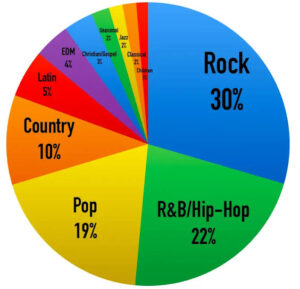
Music genres are broad categories that classify different styles and types of musical expression. There are numerous music genres, each with its own unique characteristics and influences. Some popular music genres include:
1. Pop: Pop music is a genre that prioritizes mass appeal and mainstream success, crafting songs that resonate with a wide audience. Some key characteristics of pop music include:
- Catchy melodies: Memorable, hummable tunes that stick in your head.
- Upbeat rhythms: Energetic, danceable beats that get you moving.
- Commercial appeal: Music designed to sell records, dominate charts, and fill concert venues.
- Simple harmonies: Pop music often uses straightforward chord progressions and harmonies.
- Focus on the single: Pop artists often prioritize releasing hit singles over creating cohesive albums.
- Production quality: Pop music typically features high-quality production, with polished sound and sleek mixing.
- Lyrics: Pop lyrics often focus on universal themes like love, relationships, and self-empowerment.
- Vocal performance: Pop vocalists often prioritize style and charisma over technical skill.
By blending these elements, pop music creates an infectious, radio-friendly sound that captivates listeners worldwide.
2. Rock: Rock music is a dynamic and diverse genre that has evolved over the decades, characterized by:
- Electric guitars: Often the centerpiece of rock music, providing the iconic riffs, solos, and chords that define the genre.
- Drums: Driving the rhythm and energy of rock music, drums add depth and intensity to the sound.
- Strong vocals: Powerful, emotive, and often raw, rock vocals convey the passion and intensity of the music.
Rock music comprises a wide range of subgenres, including:
- Classic rock: Drawing from the 1960s to the 1980s, classic rock is characterized by iconic bands like Led Zeppelin, The Rolling Stones, and Queen.
- Alternative rock: Emerging in the 1990s, alternative rock embraces experimentation and diversity, with bands like Nirvana, Radiohead, and Foo Fighters.
- Heavy metal: A harder, more aggressive subgenre, heavy metal is characterized by fast tempos, shredding guitars, and powerful vocals, with bands like Black Sabbath, Iron Maiden, and Metallica.
Other subgenres include:
- Punk rock
- Progressive rock
- Indie rock
- Hard rock
- Soft rock
Rock music’s evolution has led to a rich tapestry of styles, sounds, and subgenres, cementing its place as a cornerstone of modern music.
3. Hip hop: Hip hop music is a vibrant and dynamic genre that originated in African American communities in the 1970s, primarily in New York City. It encompasses a unique cultural movement that comprises:
- Rap vocals: Lyricism and storytelling that speaks to the experiences, struggles, and triumphs of urban life.
- Beats: Infectious rhythms and drum patterns that provide the foundation for hip hop’s energetic sound.
- Electronic instrumentation: Sampling, synthesizers, and other electronic elements that add depth and texture to the music.
Hip hop represents a culture that celebrates:
- Rhythm: The pulsing heartbeat of hip hop, driving the music and movement forward.
- Dance: From breaking and popping to voguing and krumping, hip hop’s dynamic dance styles have become an integral part of the culture.
- Urban expression: Hip hop provides a voice for the voiceless, addressing social issues, personal struggles, and community concerns.
Hip hop’s cultural significance extends beyond the music to encompass:
- Graffiti art
- MCing (rapping)
- DJing
- Breakdancing
- Fashion
Hip hop has evolved into a global phenomenon, influencing music, fashion, art, and social justice movements worldwide. Its impact on popular culture is undeniable, making it one of the most significant and enduring genres of our time.
4. Country: Country music is rooted in American folk traditions and features acoustic guitar, fiddle, and storytelling lyrics. It often portrays themes of love, heartbreak, and rural life.
5. Latin: Latin music encompasses various genres influenced by Latin American cultures, such as salsa, samba, merengue, and reggaeton. It is known for its vibrant rhythms and energetic dance styles.
6. Reggae: Reggae music originated in Jamaica and is characterized by offbeat rhythms, laid-back vocals, and socially conscious lyrics. It is known for its association with Rastafarianism.
7. Classical: Classical music is rooted in Western traditions and focuses on compositions by renowned composers. It includes orchestral compositions, chamber music, and opera.
8. R&B (Rhythm and Blues): R&B is a blend of African American musical styles, including soul, funk, and blues. It often showcases soulful vocals, grooves, and emotional lyrics.
9. Electronic: Electronic music is a genre that harnesses the power of technology and electronic instruments to create a diverse range of sounds, rhythms, and textures. Characterized by:
- Electronic instruments: Synthesizers, drum machines, sequencers, and software plugins generate unique sounds.
- Technology: Digital audio workstations (DAWs), effects processors, and other tools shape and manipulate sounds.
Electronic music encompasses various subgenres, including:
- Techno: Fast-paced, minimalist, and repetitive, often featuring futuristic themes.
- House: Upbeat, energetic, and groove-oriented, with roots in Chicago’s club scene.
- Trance: Melodic, atmospheric, and hypnotic, characterized by soaring leads and driving beats.
- Dubstep: Heavy, bass-driven, and rhythmic, with complex electronic production techniques.
Other subgenres include:
- EDM (Electronic Dance Music)
- Industrial
- Ambient
- Breakcore
- Glitch hop
Electronic music has evolved over the decades, influenced by:
- Krautrock
- Disco
- Punk
- Hip-Hop
- Rock
It has also led to the development of new instruments, software, and production techniques, continuously pushing the boundaries of sound and creativity. Today, electronic music is a global phenomenon, dominating clubs, festivals, and charts worldwide.
10. Jazz: Jazz music emerged in the early 20th century and is known for its improvisation, complex harmonies, and syncopated rhythms. It encompasses subgenres like Dixieland, swing, bebop, and fusion.
Music genres are constantly evolving and blending, resulting in new and unique sounds.





